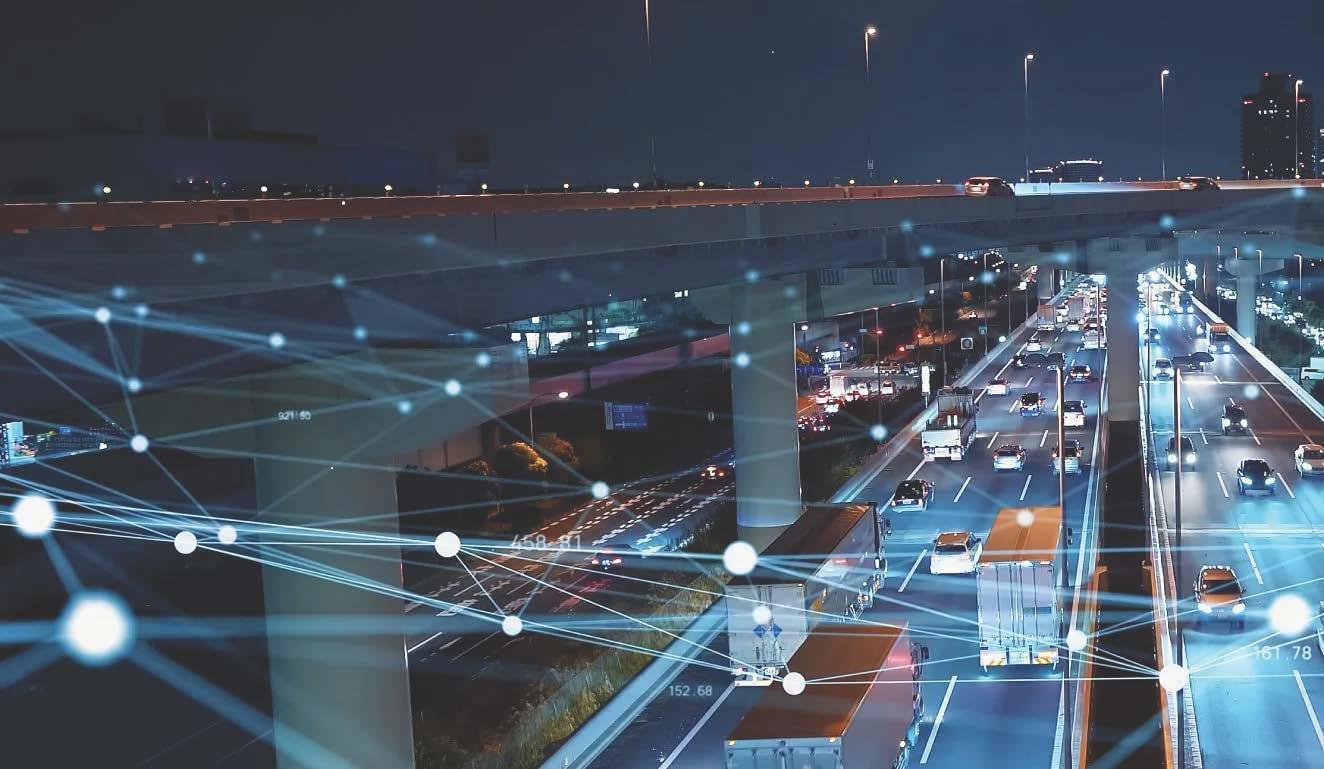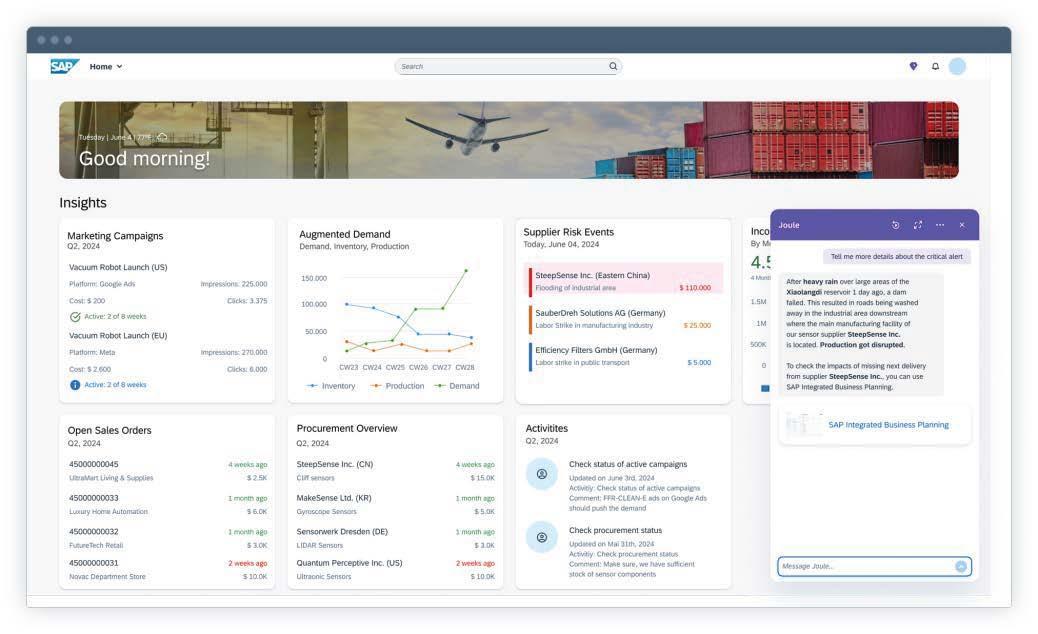
International Research Journal of Engineering and Technology (IRJET) e-ISSN: 2395-0056 p-ISSN: 2395-0072

Volume: 11 Issue: 07 | July 2024 www.irjet.net



International Research Journal of Engineering and Technology (IRJET) e-ISSN: 2395-0056 p-ISSN: 2395-0072

Volume: 11 Issue: 07 | July 2024 www.irjet.net

Sudhir Makkar
Accenture, Washington DC, USA

Abstract:
Supply chain management continues to revolutionize by integrating Artificial Intelligence (AI) with SAP's cutting-edge Transportation Management ™ systems. This study investigates how AI-trained models and algorithms enhance supply chain efficiency, visibility, and decision-making when coupled with SAP TM. SAP TM can better plan routes, forecast demand, reduce risks, and optimize costs by utilizing finetuned AI models. This results in significant cost savings, improvedservicestandards,andhighercustomersatisfaction(CSAT)scores forfirmsofallsizes Wewillalsodelveinto novel and innovative features of SAP Joule with Embedded AI and highlight how they affect supply chains and impact transportation for organizations. We will also explore into potential advantages, and challenges that AI poses vis-à-vis integration with SAP TM and future trends using an extensive literature review, a methodological framework, and the examinationofcasestudies. MultiplecasestudiesindicatethatwhileAIandTMintegrationoffersnumerousadvantages, challengessuchascost,trainingofAImodels,and siloeddata complexitiesstill needtobeaddressed. Thispaperaimsto providevaluable insights for industry practitionersand researcherson the transformative potential ofAI in SAPTM and itsimplicationsforthefutureofsupplychainmanagement.
Keywords: AI,SAPJoule,SAPTM,PlanningandOptimization,EmbeddedAnalytics,SupplyChainManagement



Volume: 11 Issue: 07 | July 2024

e-ISSN: 2395-0056 p-ISSN: 2395-0072

Recentadvancements,in technologyandtheincreasingcomplexityoflogistics,arecausingchangesintheglobal supply chain landscape. One notable development is the integration of intelligence (AI) with SAP Transportation Management (TM)solutions,whichhasyieldedgoodresults[1].Thiscollaborationaimstoenhanceefficiency,visibility,anddecisionmaking processes, within supply chain management. The ability of AI to analyze amounts of data and identify patterns, provide valuable insights has the potential to revolutionize how supply chains are executed and managed. When combined with SAP TM; AI can help reduce risks, optimize route planning, forecast demand, and achieve cost savings. Theseimprovementscanleadtocustomersatisfactionratingsimprovedservicequalityandsubstantialfinancialbenefits.
TheintegrationofAIwithSAPTMisnotmerelyanenhancementbutafundamentalshifttowardssuperintelligentsupply chains. AI-powered SAP TM systems can dynamically adapt to changing conditions, optimize routes based on real-time data,forecastfreightdemandwithremarkableaccuracy,andmitigaterisksproactively.SAPJoule,acutting-edgefeature with embedded AI, exemplifies this advancement. Joule leverages sophisticated AI algorithms to provide actionable insightsand recommendations,enablingcompaniesto achieveoptimal logisticsperformanceandcustomersatisfaction. According to SAP [4], Joule's real-time capabilities significantly improve decision-making processes and operational resilience.
The purpose of this article is to examine how artificial intelligence (AI) is revolutionizing SAP TM and its impact on supply chain systems. We will look at the features and advantages of SAP TM with AI, concentrating on SAP Joule, a brand-newintegratedAIfeature.Wewilldeterminethebenefits,possibletrends,andchallengesrelatedtoAIintegration in SAP TM by thorough literature research and the examination of case studies. This study seeks to give industry practitioners, technology enthusiasts, and academic scholars useful insights by offering a thorough knowledge of AI's function in SAP TM. Our research will highlight the most effective methods and tactical suggestions for using AI to give logisticsandtransportationmanagementacompetitiveedge.
The transportation industry has a significant impact on cost, sustainability of the environment, and efficiency in global supplychains.Newtechnologies offergreatpromiseforstreamlining supplychain operationsand help buildsmartand “intelligent" supply chains. The literature review offers a thorough analysis of previous studies on supply chain management effects of AI integration with SAP Transportation Management (TM) systems. The use of AI to optimize logistics,SAPTMfunctionalities,andtheadvantagesanddifficultiesofAIintegrationaresomeofthemajorsubjects.
Studies by Waller and Fawcett [6] emphasize AI's potential to improve visibility and responsiveness in supply chains. ResearchbyThobenetal.[5]underlinesthatAI-poweredSAPTMcanpredictdemandpatterns,optimizetransportation routes, and mitigate disruptions, leading to improved supply chain performance. Studies by Kache and Seuring [2] highlight the importance of data quality and integration in realizing the full potential of AI in SAP TM. SAP TM is a comprehensive suite designed to optimize transportation and logistics processes. According to Sandberg and Abrahamsson [3], SAP TM offers functionalities such as route planning, carrier selection, and freight settlement, which streamline logistics operations and improve service levels. The integration of AI with SAP TM enhances its capabilities, enablingadvancedanalyticsandreal-timevisibility.
AI's role in risk management is another critical area explored in the literature. Waller and Fawcett [6] underscore the importance of AI in enhancing supply chain resilience by proactively managing risks and uncertainties. AI can detect anomalies and predict potential risks, enabling companies to take preventive measures and avoid costly disruptions. ResearchersareexploringhowAIcanhelpreducecarbonfootprintsbyoptimizingtransportationroutesandimproving energyefficiency(Wuestetal.,2018)[5].Additionally,AIcanenhancetransparencyinsupplychains,enablingcompanies totracetheoriginofproductsandensureethicalsourcingpractices.
This methodology encompasses a mixed-methods approach, combining quantitative data analysis with qualitative insightstoensurearobustandholisticunderstandingofthesubject.



Volume: 11 Issue: 07 | July 2024
3.1 Review
International Research Journal of Engineering and Technology (IRJET) e-ISSN: 2395-0056 p-ISSN: 2395-0072
www.irjet.net


The initial phase involves an extensive literature review to gather and synthesize existing knowledge on innovation
trends in AI, Supply chain management, SAP Joule, and TM. Scholarly articles, industry reports, and case studies are examined to identify key AI technologies, benefits, and challenges associated with their integration into transportation managementsystems.
3.2
The phase involved informal interviews with my peers, industry practitioners and subject matter experts, and IT
professionalsinmynetworkintheTransportationsectorinNorthAmericaandEuroperegion.Myapproachwastoglean insights from their experience and point of view on leveraging emerging technologies in the SAP Supply Chain & Operations,embeddedAIanalyticsusingSAPJoule,andthetransportationdomain overall.Thematicanalysisisapplied to the interview transcripts to identify common themes and patterns in the data. Recommendations from senior executives and industry leaders in AI and transportation have been studied, analyzed, and synthesized to better understandnuances,adoptionbarriers,benefits,andtechnologicalchallenges.
4.1
SAP Joule is a new AI Copilot offering from SAP, and it revolutionizes end-user interaction with SAP business systems,
making every touchpoint count and every task simpler and more intelligent [4] Users just need to ask a question or frameanissuetoreceiveinsightsandintelligentresponsesfromawealthofbusinessdataacrossSAPportfolioandthirdpartysourcesretainingcontext.

Figure 1 below analyzes supply chain performance by relying on Joule’s analysis of planning runs. Joule helps identify supplychaindelaysandsuggestscorrectivemeasuresandembeddedanalytics.





2395-0072

Jouleisamultitenantsoftwareasaservice(SaaS)applicationintheSAPBusinessTechnologyPlatform(BTP).Itenablesthe companion of the Intelligent Enterprise, guiding you through content discovery within the SAP Ecosystem, and giving transparentrole-basedaccesstotherelevantprocessesfromeverywhere.
PerSAPLabs,thefollowingfeaturesareavailableforJoule:
Key Features Use
IntegrationwithSAPapplication
ConversationaluserinterfacethatisintegratedwithSAPapplications.Itisarichweb clientthatrendersassistantresponsesusingSAPFiori-compliantUIcontrols. Enterprise-readiness
Out-of-the-boxintegrationwithSAPbackendsystems.CompliancewithAIethics,GDPR, andprivacycontrolswithSOC-IIcompliance.
Publishandsubscribemechanism. CapabilitiesbasedonyourSAPsolutionportfolioarebundledintoauniquedigital assistant.
Automaticupdates
Automaticallyupdatedwheneverthecapabilitiesareaddedorchanged. Smalltalk Joulecanrespondtogreetingsandcasualconversation.
ConversationalSearch
IfJouleisunabletomatchtheuser'squerywithasuitableintent,itperformsa conversationalsearchonSAPHelpPortalcontentasafallbackmechanismandthe resultisdisplayed.
SAP Joule brings a spark to the interaction of the user, with the transportation cockpit. One could easily think of various options in which Joule can complement the transportation planners who are responsible for planning transportation demand, finding the cheapest carrier, seeing if there is an alternate route available, and asking “What if” simulation questions.
4.3.1 Text to action - As of today, transportation planners are clicking their way to perform any action. With Joule, the Transportation planners can issue commands such as "Plan all open demands with a Good Issue date in the next 2





2395-0056 p-ISSN: 2395-0072
Volume: 11 Issue: 07 | July 2024 www.irjet.net days." or “Plan all freight units originating from Peachtree City”. The data model would be trained to use these commands,querythedataset,andperformtheplanningaction.
4.3.2 Freight Rating - Oneofthemostcriticaldatapointsinlogisticsisthehistoricfreightspentbythecarrier,bylane,by product, etc. With the power of AI, now we can understand historic freight spend trends, combine them with seasonality, peak season volumes, and carrier performance, and ask Joule in the future what can be the potential freight rate for a lane for next year. This will fuel the procurement part of the freight negotiations and provide transportationplannerswith thecurrentcosts ofcarrierswithouthavingtoclick multiplebuttons.Thiscould then beofferedtothecustomerserviceagents,whosometimesneedtoknowthecostoffreightforthelaneonwhichthe customerisordering,itcanevenaddamarkupbasedontrends.
4.3.3 What-If Simulation - Awhitegapthathasexistedsofarinlogisticshasbeenawhat-ifsimulationscenario.Whatif my product was 200LB instead of 100LB, how would this impact my routing and freight spend, or, what if these orderswereshippedonaless-than-truckload(LTL)vs.fulltruckload(FTL),wouldtherebeanysavings?Wecansee this gap being filled by Joule as it is specifically trained on such models. Even with master data, a lot of time, one must change the master data to run a simulation. Ideally, Joule could change the master data, transiently, for simulations,withoutimpactingthecoremasterdatainthedatabase.Thisempowersthebusinesstounderstandthe impactofchangestomasterdata,evenbeforecommittingtothechanges[16].
4.3.4 Lack of visibility across the value chain – Supply chains today are devoid of real-time end-to-end visibility and planners and customers alike are compelled to wait or wonder as to what happened to their order planned or shipped [7,8]. Change documents have been an ineffective way for a user to decipher what happened to the order, applicationlogsarenotthatexplanatory,andeventually,thebusinessmustgetintouchwithitsinternalITteamto help. Joulecouldreadall changedocuments,fields, and values,andprovidea summaryofit. Withpotential impact andchangeanalysis.
Everynewtechnologypresentsitselfwithnewchallengesforitscreatorsandusers. EventhoughIntegratingAIintoSAPTM is a leap forward, multiple barriers must be addressed to ensure seamless integration. These span across technical, organizational,financial,ethical,andresponsibleAIdomains.
5.1 Technical Challenges - Despite all the hype around digital transformation and business modernization, data often resides in disparate sources and formats. Organizations often do not have a single source of truth to ensure data's explainabilityconsistencyandtransparency AIalgorithmsrelyheavilyonvolumesofaccuratedatatopredictaccurately. AccordingtoKache[2,11],inconsistentdataleadstopoorandhallucinatedoutputsrenderingAIinsightsunreliable and leading to poor decision making. Another hurdle in integrating AI-TM is the existing antiquated legacy infrastructure. Extensivemodificationsorinsomecasesa360-degreeoverhaulofthecurrentlandscapemayberequiredtoincorporate AIsolutions,andthisisbothtime-consuming,costly,anddisruptive.[1,9].
5.2 Organizational Hurdles - AI technologies are surrounded by preconceived myths such as fear of job displacement or resistance to change management. Employees resist these changes due to skills gaps or lack of training and clear communication from management. This gap needs to be bridged by ensuring employees are upskilled or new talent is recruitedwhichwouldleadtosubstantialinvestment[11].
5.3 AI Ethics – As AI technologies become mainstream, concerns around ethics and models being trustworthy, and responsible continue to gain more buzz. Any bias or toxicity in AI systems can lead to unfair results, and treatment of carriers, suppliers, or customers which can damage the organization's credibility or lead to legal implications. [8]. Another important consideration is ensuring the sensitive and private data of organizations, shippers, and carriers is secure and that AI models comply with regulations such as the AI Privacy Act with the European Union or the General DataProtectionRegulation(GDPR)inEurope[9].
5.4 Financial – Research from Gartner and McKinsey [10, 20] cites it would take a couple of years for AI to become commoditizedastheinitialinvestmentinAIalgorithms,models,andinfrastructureisprohibitiveandcanbeasignificant barrier to adoption. Furthermore, for businesses today, demonstrating a clear Return on Investment (ROI) from AI integration is often challenging and is not as apparent as businesses would like. [6]. This uncertainty can hinder the adoptionofAItechnologiesfurther.




2395-0056 p-ISSN: 2395-0072

6.1 Consolidated learnings from Literature - Thelearningsfrommultiplecasestudiesrevealaconsistentpatternwhichis that “AI enhances the predictive and prescriptive capabilities of SAP TM, leading to more agile, resilient, and responsive supply chains”. This integration not only improves operational metrics but also contributes to higher customersatisfactionandcompetitiveadvantage.Casestudiesfromvariousverticalsandindustries,suchasautomotive, retail,andlogistics,confirmthesefindingsbyshowcasingtangiblebenefits.Wewilldiscuss twoexamplesfromtheFood &BeverageandShippingsectortocorroborateandbolsterourresearch
6.1.1 Coco-Cola – By leveraging AI algorithms, Coco-Cola can optimize and predict its distribution network more accurately AI-driven route optimization has resulted in a 20% reduction in delivery times resulting in improved planningandreal-timeadjustmentstoroutesbasedontraffic,congestion,weather,andothervariables.TheuseofAI foroptimizingdeliveryrouteshasledtoa5%reductioninfuelconsumption,contributingtobothcostsavings and environmental benefits. This has led to faster restocking of products at retail locations, ensuring that customers alwaysfindtheirfavoritebeveragesavailable[13].
6.1.2 Maersk - Maersk,apioneerinlogisticsandcontainershippingworldwide,deploysAItoexpeditedeliverytimesand optimize its shipping routes. Maersk uses AI models to determine the most effective itineraries for its vessels by analyzing data on shipping lanes, weather, and port congestion [14]. As a result, cargo transportation has become more reliable and transit times have decreased but fuel consumption has increased. Maersk's ability to provide inexpensive shipping services and satisfy the demands of international trade is largely due to its use of AI in route planning.
MaerskhaspubliclyshareditscommitmenttousingAIandpredictiveanalyticstooptimizeitsshippingroutesand operations. It has reduced its average transit times by leveraging AI and predictive analytics to streamline operations and optimize routes." [14]. Maersk has implemented AI technologies to achieve cost efficiencies and reduce emissions "AI-driven optimization has led to a 15% reduction in shipping costs and a 7% decrease in CO2 emissions."[14,15].
6.2 Implications for Theory and Practice -TheuseofAIinSAPTMhasrippleeffectsonsupplychainmanagementbothin theory and practice. By introducing dynamic, data-driven decision-making business processes, this integration challenges conventionalsupplychainnormsonforecasting,inventorymodeling,andtransportationmanagementmodels.Moreaccurate risk assessment, forecasting, and logistics operation optimization are made possible by AI algorithms' capacity to evaluate enormousvolumesofdatainrealtime.ThecreationofnewtheoreticalframeworksthattakeAI'spredictiveandprescriptive powersintoaccountisimperativeconsideringthisparadigmshift. Practicallyspeaking,theintegrationaffectstheday-to-day managementofsupplychainoperations.Efficiency,costsavings,andcustomer satisfactioncanallbesignificantlyincreased forbusinessesusingAI-poweredSAPTMsystems.Forexample,automateddemandforecastingandrouteplanningallowfor more accurate and timely delivery, which lowers operating costs raises service standards, and helps in companies' sustainabilitytargets.
6.3 Potential for Future Research - Thereisimmenseresearchandgrowthpotentialintheintegrationoftwotechnologies (AI,TM).ThecreationofsophisticatedAIalgorithmsdesignedespeciallyfortransportationandfreight,cargoapplicationsis one fieldthat needsmore data and research. Fine-tuningandgroundingtheseAImodels will further enhance theprecision and effectiveness of algorithms and supply chain practitioners are already investigating this area for future research, especiallyinfieldslikedemandforecastingandreal-timeroute planning.InvestigatingAI'spotential contributiontosupply chainsustainabilityisanotherexcitingfield.FutureresearchcouldexplorehowAIcanhelpsupplynetworksbecomegreener byoptimizingresourceuseandminimizingitsimpactontheenvironment.Furthermore,morefocusneedstobepaidtothe moral and ethical ramifications of integrating AI into supply chains. Frameworks for protecting data privacy, correcting algorithmic biases,andadheringtolegal obligationscouldall bethesubject offuture research [17,18] Finally,longitudinal research studies monitoring thelong-termeffectsofAI onsupplychain efficiencyandorganizational resilience wouldyield importantinformation.Findingthebesttechniquesforlong-termdeploymentandcalculatingthereturnoninvestmentforAI investmentsmaybeaidedbythisresearchaswell.



e-ISSN: 2395-0056 p-ISSN: 2395-0072 Volume: 11 Issue: 07 | July 2024


TheintegrationofArtificialIntelligence(AI)withSAP'sTransportation Management(TM)technologiessignalsanewerain supply chain management, characterized by unprecedented efficiency, transparency, and strategic decision-making. This study explored the various ways AI enhances supply chain operations when combined with SAP TM, identifying multiple benefits,challenges,andpotentialfuturedirections. SynergiesbetweenAIandSAPTMenableimproveddemandforecasting, optimized freight and route planning, and resilient business processes in the supply chain. AI algorithms, trained on extensive datasets, provide highly accurate demand forecasts, which are essential for maintaining optimal inventory levels and meeting customer expectations. Retail and e-commerce industry leaders such as Amazon and UPS demonstrate the transformativeimpactofAIonrouteoptimization,significantlyreducingdeliverytimesandoperationalcosts[21,22].
With its embedded and intelligent AI features, SAP Joule represents a significant leap forward in supply chain technology. Through the utilization of real-time data analytics and sophisticated decision-making functionalities [23]f, SAP Joule facilitatespromptresponsesfromenterprisestodynamicmarketconditions,thereforeaugmentingservicequalityandclient contentment.Itspredictivemaintenancefeaturesalsoreducedowntimeandrelatedexpenses,resultinginamorerobustand effectivesupplychain.
FuturedevelopmentsinAItechnologyandthe growing needformorereliableand resilientsupplychainsare predictedto drive further changes in the integration of AI with SAP TM systems. Subsequent studies ought to concentrate on creating increasingly complicated AI algorithms that can manage the intricacies of international supply chains, such as cross-border logistics and multi-modal transportation. Further research into how AI might improve supply chain sustainability is also a worthwhile endeavor. Greener supply chains can be achieved using AI, which can optimize resource utilization and lessen environmentaleffects To fully understand the ethical and legal ramifications of integrating AI, it is recommended that companies and subject matter experts in academia investigate mechanisms that guarantee algorithmic fairness, equity, and responsibility, specifically in the context of model outputs as they impact decision-making procedures. According to McKinsey [24] studiesthatfollowthe long-term effects ofartificial intelligence(AI) onorganizational resilience andsupply chainperformancewouldyieldimportantinsightstocalculateROIandpinpointsustainableadoptionbestpractices.
References
[1] Ivanov,D.,Dolgui,A.,& Sokolov,B.(2019). Theimpact ofdigital technology andIndustry4.0 on the ripple effectand supplychainriskanalytics.InternationalJournalofProductionResearch,57(3),829-846.
[2] Kache, F., & Seuring, S. (2017). Challenges and opportunities of digital information at the intersection of Big Data Analyticsandsupplychainmanagement.InternationalJournalofOperations&ProductionManagement,37(1),10-36.
[3] Sandberg, E., & Abrahamsson, M. (2011). Logistics capabilities for sustainable competitive advantage. International JournalofLogisticsResearchandApplications,14(1),61-75.
[4] SAP. (2021). SAP Transportation Management: Transforming the Future of Supply Chain. https://www.sap.com/products/transportation-management.html
[5] Thoben,K.D.,Wiesner,S.A.,&Wuest,T.(2017)."Industry4.0"andsmartmanufacturingreviewofresearchissuesand applicationexamples.InternationalJournalofAutomationTechnology,11(1),4-16.
[6] Waller,M.A.,&Fawcett,S.E.(2013). Datascience,predictiveanalytics,andbigdata:arevolutionthatwilltransform supplychaindesignandmanagement.JournalofBusinessLogistics,34(2),77-84.
[7] Bowersox,D.J.,Closs,D.J.,&Cooper,M.B.(2013).Supplychainlogisticsmanagement.McGraw-Hill.
[8] Floridi,L.,Cowls,J.,Beltrametti,M.,Chatila,R.,Chazerand,P.,Dignum,V.,...&Schafer,B.(2018).AI4People anethical frameworkforagoodAIsociety:opportunities,risks,principles,andrecommendations.MindsandMachines.
[9] GeneralDataProtectionRegulation(GDPR).(2018).Regulation(EU)2016/679oftheEuropeanParliamentCouncil.
[10]McKinsey&Company.(2018).TheAIfrontier:Applicationsandvalueofdeeplearning.



Volume: 11 Issue: 07 | July 2024
International Research Journal of Engineering and Technology (IRJET) e-ISSN: 2395-0056 p-ISSN: 2395-0072
www.irjet.net


[11] Thoben, K. D., Wiesner, S. A., & Wuest, T. (2017). "Industrie 4.0" and smart manufacturing a review of research
issuesandapplicationexamples.InternationalJournalofAutomationTechnology,11(1),4-16.
[12]CiscoonAI-DrivenSupplyChains:"HarnessingAItoBuildSmarterSupplyChains."Cisco,2020.
[13]SupplyChainDigital."Coca-ColaoptimizessupplychainwithAI-drivenlogistics."2020.
[14]MaritimeExecutive."MaerskusesAItorevolutionizeshippinglogistics."2021.
[15]MaerskAnnualReport:"MaerskAnnualReport2021,"A.P.Moller-Maersk
[16] AI in Route Planning - s, M., & Manyika, J. (2018). "Smartening up with Artificial Intelligence (AI): What's in it for GermanyanditsIndustrialSector?"McKinseyGlobalInstitute.
[17]SupplyChainDiveArticleonAI:"HowAIIsTransformingSupplyChains,"SupplyChainDive,
[18]DeloitteInsightsonAIinSupplyChain:"ArtificialIntelligenceinSupplyChain:EnablingEfficiency."DeloitteInsights, 2019.
[19]PwConAIinLogistics: "ArtificialIntelligenceandMachineLearninginLogistics."PwC,2018.
[20]GartnerReportonAIandSupplyChain:"TopTrendsinSupplyChainfor2021:TheRiseofAI."
[21]HarvardBusinessReview:"HowAIIsReshapingSupplyChainManagement."HBRReview,2019
[22]AccentureonAIinSupplyChains,2020:"DrivingValueandEfficiencywithAIinSupplyChains."
[23]IBMonAIandSupplyChainResilience:"LeveragingAIforEnhancedSupplyChainResilience."
[24] McKinsey & Company on AI inSupplyChains: "The rise of the digital supply chain: How AI andanalytics aretransforminglogistics

